Serving 152 students in grades 7-12, Divide County High School ranks in the bottom 50% of all schools in North Dakota for overall test scores (math proficiency is bottom 50%, and reading proficiency is bottom 50%).
The percentage of students achieving proficiency in math is 20-24% (which is lower than the North Dakota state average of 39%). The percentage of students achieving proficiency in reading/language arts is 30-34% (which is lower than the North Dakota state average of 44%).
The student:teacher ratio of 10:1 is lower than the North Dakota state level of 11:1.
Minority enrollment is 15% of the student body (majority Hispanic), which is lower than the North Dakota state average of 29% (majority American Indian).
Quick Stats (2025)
- Grades: 7-12
- Enrollment: 152 students
- Student:Teacher Ratio: 10:1
- Minority Enrollment: 15%
- Graduation Rate: ≥80% (Top 30% in ND)
- Overall Testing Rank: Bottom 50%
- Math Proficiency: 20-24% (Btm 50%)
- Reading Proficiency: 30-34% (Btm 50%)
- Science Proficiency: 40-49% (Btm 50%)
- Source: National Center for Education Statistics (NCES), ND Dept. of Education
Top Rankings
Divide County High School ranks among the top 20% of public schools in North Dakota for:
Category
Attribute
Student Attention
School Overview
Divide County High School's student population of 152 students has declined by 7% over five school years.
The teacher population of 16 teachers has grown by 6% over five school years.
Grades Offered
Grades 7-12
(offers virtual instruction)
(offers virtual instruction)
Total Students
152 students
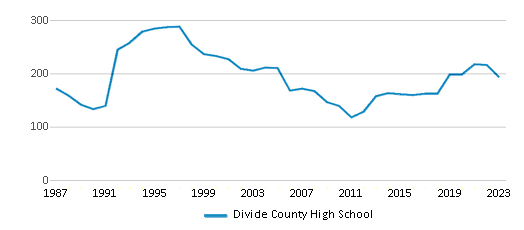
Gender %

Total Classroom Teachers
16 teachers
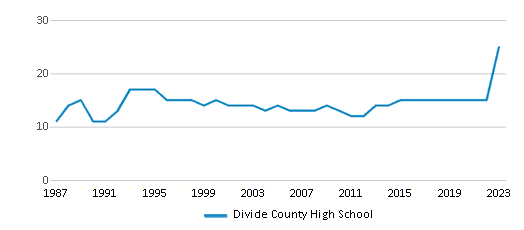
Students by Grade
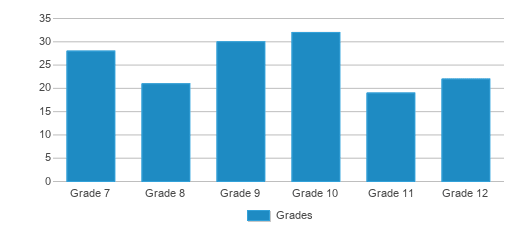
School Rankings
Divide County High School ranks within the bottom 50% of all 461 schools in North Dakota (based off of combined math and reading proficiency testing data).
The diversity score of Divide County High School is 0.27, which is less than the diversity score at state average of 0.48. The school's diversity has stayed relatively flat over five school years.
Overall Testing Rank
#408 out of 461 schools
(Bottom 50%)
(Bottom 50%)
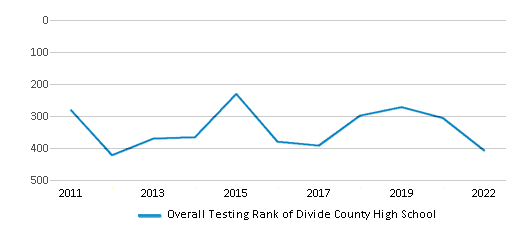
Math Test Scores (% Proficient)
20-24%
39%
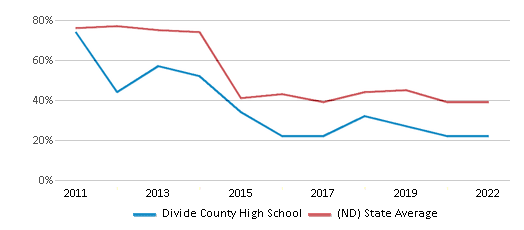
Reading/Language Arts Test Scores (% Proficient)
30-34%
44%
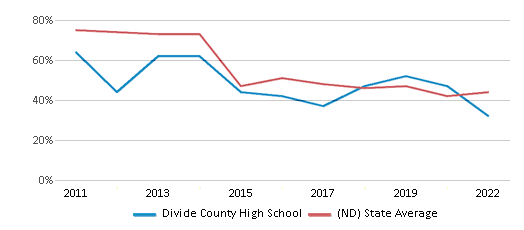
Science Test Scores (% Proficient)
40-49%
44%
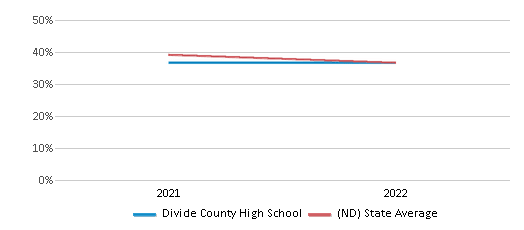
Student : Teacher Ratio
10:1
11:1
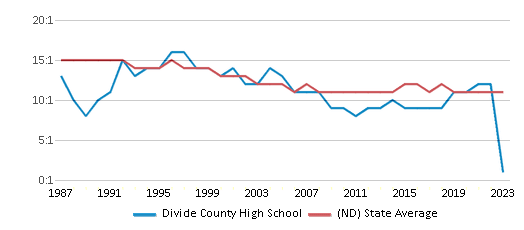
American Indian
1%
11%
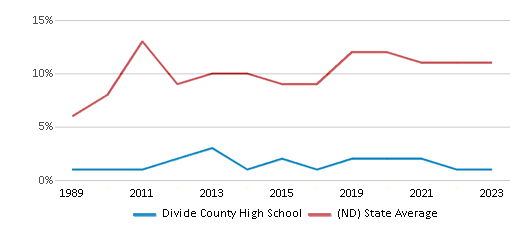
Asian
1%
1%
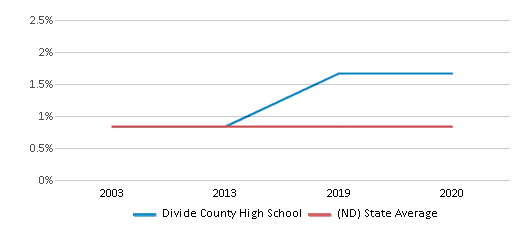
Hispanic
8%
7%
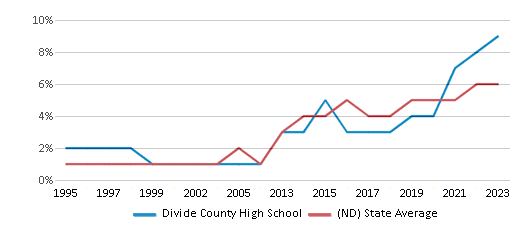
Black
1%
5%
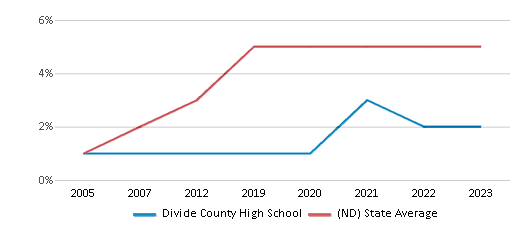
White
85%
71%
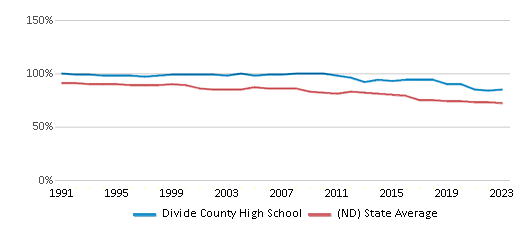
Hawaiian
n/a
n/a
Two or more races
4%
5%
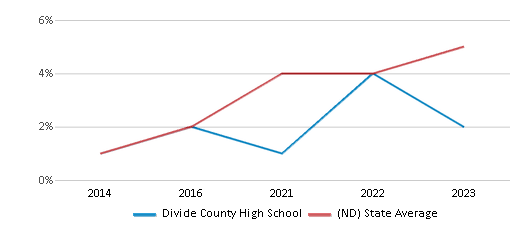
All Ethnic Groups

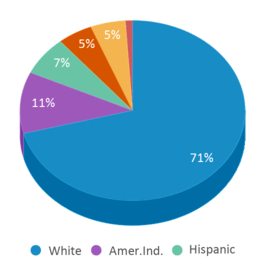
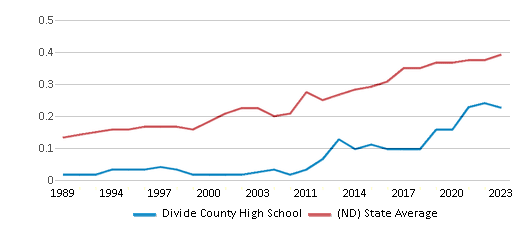
Graduation Rate
≥80%
85%
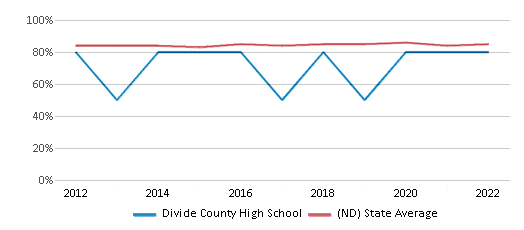
Eligible for Free Lunch
17%
26%
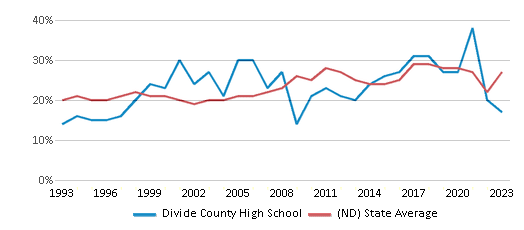
Eligible for Reduced Lunch
6%
6%
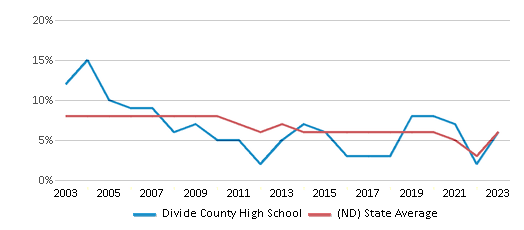
School Statewide Testing
School District Name
Source: National Center for Education Statistics (NCES), ND Dept. of Education
Profile last updated: 02/09/2025
Frequently Asked Questions
What is Divide County High School's ranking?
Divide County High School is ranked #408 out of 461 schools, which ranks it among the bottom 50% of public schools in North Dakota.
What percent of students have achieved state testing proficiency in math and reading?
20-24% of students have achieved math proficiency (compared to the 39% ND state average), while 30-34% of students have achieved reading proficiency (compared to the 44% ND state average).
What is the graduation rate of Divide County High School?
The graduation rate of Divide County High School is 80%, which is lower than the North Dakota state average of 85%.
How many students attend Divide County High School?
152 students attend Divide County High School.
What is the racial composition of the student body?
85% of Divide County High School students are White, 8% of students are Hispanic, 4% of students are Two or more races, 1% of students are American Indian, 1% of students are Asian, and 1% of students are Black.
What is the student:teacher ratio of Divide County High School?
Divide County High School has a student ration of 10:1, which is lower than the North Dakota state average of 11:1.
What grades does Divide County High School offer ?
Divide County High School offers enrollment in grades 7-12 (offers virtual instruction).
What school district is Divide County High School part of?
Divide County High School is part of Divide County 1 School District.
School Reviews
1 2/10/2020
The teacher in this school pick favorite student and with those favorite they give them unfair advantages such as a higher grade. One of my teachers does not like me so that teacher gave me a D in their class but when I averaged out my grades, it should have been a C+. Our principal is another problem, he is only concerned about a certain student and he doesn't even talk to the other students. This school has about 130+ students so it's not that hard to talk to each of them at least once in the four years we are going to be here. One of the few good things about this school is our Guidance Counselor, she makes a personal connection with every student and she genuinely cares. Other teachers act like they hate you when they might not but they still act like it. The new teachers form 2019-2020 I, and many others feel like they should not have been hired. They don't know how to listen to students when they need help and they are generally not very good teachers. Yes a few of them did a very good job in the athletics department, with helping the Jr. High teams but I personally think that is all they are good for.
2 9/24/2006
The availability and ability to participate in extracurricular activities is excellent, because it is a small town and you can be involved in many activities. However, the administration of this school (superintendent and high school principal) are very set in their ways, opposed to changes that could be beneficial to the school system, and frequently biased in the ways they treat their staff.
Review Divide County High School. Reviews should be a few sentences in length. Please include any comments on:
- Quality of academic programs, teachers, and facilities
- Availability of music, art, sports and other extracurricular activities
Recent Articles

What Is A Charter School?
Explore the world of charter schools in this comprehensive guide. Learn about their history, how they operate, and the pros and cons of this educational innovation. Discover key facts about charter schools, including admission policies, demographics, and funding, as well as what to look for when considering a charter school for your child.

10 Reasons Why High School Sports Benefit Students
Discover the 10 compelling reasons why high school sports are beneficial for students. This comprehensive article explores how athletics enhance academic performance, foster personal growth, and develop crucial life skills. From improved fitness and time management to leadership development and community representation, learn why participating in high school sports can be a game-changer for students' overall success and well-being.

February 05, 2025
Understanding the U.S. Department of Education: Structure, Impact, and EvolutionWe explore how the Department of Education shapes American education, from its cabinet-level leadership to its impact on millions of students, written for general audiences seeking clarity on this vital institution.









